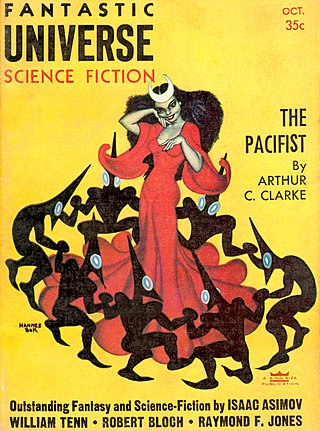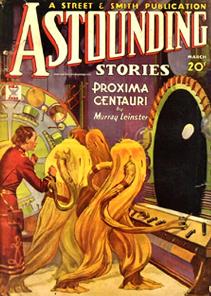Related Research Articles

Isaac Asimov was an American writer and professor of biochemistry at Boston University. During his lifetime, Asimov was considered one of the "Big Three" science fiction writers, along with Robert A. Heinlein and Arthur C. Clarke. A prolific writer, he wrote or edited more than 500 books. He also wrote an estimated 90,000 letters and postcards. Best known for his hard science fiction, Asimov also wrote mysteries and fantasy, as well as popular science and other non-fiction.
"Blind Alley" is a science fiction short story by American writer Isaac Asimov. It was first published in the March 1945 issue of Astounding Science Fiction, and later included in the collection The Early Asimov (1972).
"Robbie" is a science fiction short story by American writer Isaac Asimov. It was the first of Asimov's positronic robot stories. In 2016, "'Robbie" won a retrospective 1941 Hugo Award for best short story. "Robbie" was the fourteenth story written by Asimov, and the ninth to be published. It was the first story in Asimov's Robot series.

The Best of Isaac Asimov is a collection of twelve science fiction short stories by American writer Isaac Asimov, published by Sphere in 1973. It begins with a short introduction giving various details on the stories, such as how they came to be written, or what significance merits their inclusion in a "best of" collection, as well as some of Dr. Asimov's thoughts on a best of collection itself. The stories included are two of his early works, two of his late works (post-1960), and eight from the 1950s, which he refers to as his "golden decade" in the introduction. Except for the last story in the book, "Mirror Image", none of the stories are related to his Robot and Foundation series, while a few mention the Multivac computer.
This is a list of short stories by American writer Isaac Asimov. Asimov is principally known for his science fiction, but he also wrote mystery and fantasy stories.

The Early Asimov or, Eleven Years of Trying is a 1972 collection of short stories by Isaac Asimov. Each story is accompanied by commentary by the author, who gives details about his life and his literary achievements in the period in which he wrote the story, effectively amounting to a sort of autobiography for the years 1938 to 1949.
The Golden Age of Science Fiction, often identified in the United States as the years 1938–1946, was a period in which a number of foundational works of science fiction literature appeared. In the history of science fiction, the Golden Age follows the "pulp era" of the 1920s and 1930s, and precedes New Wave science fiction of the 1960s and 1970s. The 1950s are, in this scheme, a transitional period. Robert Silverberg, who came of age then, saw the 1950s as the true Golden Age.

"First Law" is a science fiction short story by American writer Isaac Asimov, first published in the October 1956 issue of Fantastic Universe magazine and later collected in The Rest of the Robots (1964) and The Complete Robot (1982). The title of the story is a reference to the first of the Three Laws of Robotics.
"Not Final!" is a science fiction short story by American writer Isaac Asimov, originally published in the October 1941 issue of Astounding Science Fiction, and included in the 1972 collection The Early Asimov. Its sequel, "Victory Unintentional", is a robot story. These are two of the few stories by Asimov to postulate non-human intelligences in the Solar system.
Robert Thurston was a science fiction author well known for his works in popular shared world settings.
"Author! Author!" is a fantasy short story by American writer and scientist Isaac Asimov.

Before the Golden Age: A Science Fiction Anthology of the 1930s is an anthology of 25 science fiction stories from 1930s pulp magazines, edited by American science fiction writer Isaac Asimov. It also includes "Big Game", a short story written by Asimov in 1941 and never sold. The anthology was first published in April 1974, and won the 1975 Locus Award for Best reprint anthology.
"Breeds There a Man...?" is a science fiction short story by American writer Isaac Asimov. It was first published in the June 1951 issue of Astounding and was reprinted in science fiction anthologies such as Beachheads in Space (1952) and The Great SF Stories #13 (1951), as well as in Asimov-only collections such as Through a Glass, Clearly (1967), Nightfall and Other Stories (1969). and Robot Dreams (1986).
"Day of the Hunters" is a science fiction short story by American writer Isaac Asimov. It was published in the November 1950 issue of Future Combined with Science Fiction Stories, edited by Robert W. Lowndes, and reprinted in the 1975 collection Buy Jupiter and Other Stories. "Day of the Hunters" is based on "Big Game", a story written many years earlier that was unpublished and assumed to have been lost until discovered in the author's collected papers at Boston University.
"Time Pussy" is an early science fiction short story by American writer Isaac Asimov.

"Proxima Centauri" is a science fiction short story by American writer Murray Leinster, originally published in the March 1935 issue of Astounding Stories. Unusually for the time, the story adhered to the laws of physics as they were known by showing a starship that was limited by the speed of light and took several years to travel between the stars. In his comments on the story in Before the Golden Age, Isaac Asimov thought that "Proxima Centauri" must have influenced Robert A. Heinlein's later story "Universe" and stated that it influenced his own Pebble in the Sky.
"The Weapon" is a short story by the American science fiction writer Isaac Asimov. Written in September 1938 when Asimov was 18, it was first published in the May 1942 issue of Super Science Stories under a pseudonym, H.B. Ogden. Because of the pseudonym, Asimov forgot that this story had ever been published and so, assuming that it had been rejected and believing that he no longer had a copy of it, he omitted it from The Early Asimov (1972), a collection of his earliest stories. In that book he listed "The Weapon" among eleven of his short stories that had been lost forever. However, while writing the first volume of his autobiography, In Memory Yet Green (1979), Asimov came across an entry in his diary which reminded him that the story had indeed been published. Obtaining a copy of the relevant magazine, he ensured that the story was published in chapter 30 of that book.
In a writing career spanning 53 years (1939–1992), science fiction and popular science author Isaac Asimov (1920–1992) wrote and published 40 novels, 383 short stories, over 280 non-fiction books, and edited about 147 others.
Isaac Asimov wrote three volumes of autobiography. In Memory Yet Green (1979) and In Joy Still Felt (1980) were a two-volume work, covering his life up to 1978. The third volume, I. Asimov: A Memoir (1994), published after his death, was not a sequel but a new work which covered his whole life. This third book won a Hugo Award.
Depending on the counting convention used, and including all titles, charts, and edited collections, there may be currently over 500 books in Isaac Asimov's bibliography—as well as his individual short stories, individual essays, and criticism. For his 100th, 200th, and 300th books, Asimov published Opus 100 (1969), Opus 200 (1979), and Opus 300 (1984), celebrating his writing.
References
- ↑ Asimov, I. (1981). In Joy Still Felt . Avon Books. p. 582.
- ↑ Asimov, I. (1973) Buy Jupiter and Other Stories Doubleday
- ↑ Asimov, I. (1980) In Memory Yet Green, Avon Books, pp. 329–330, 363–364